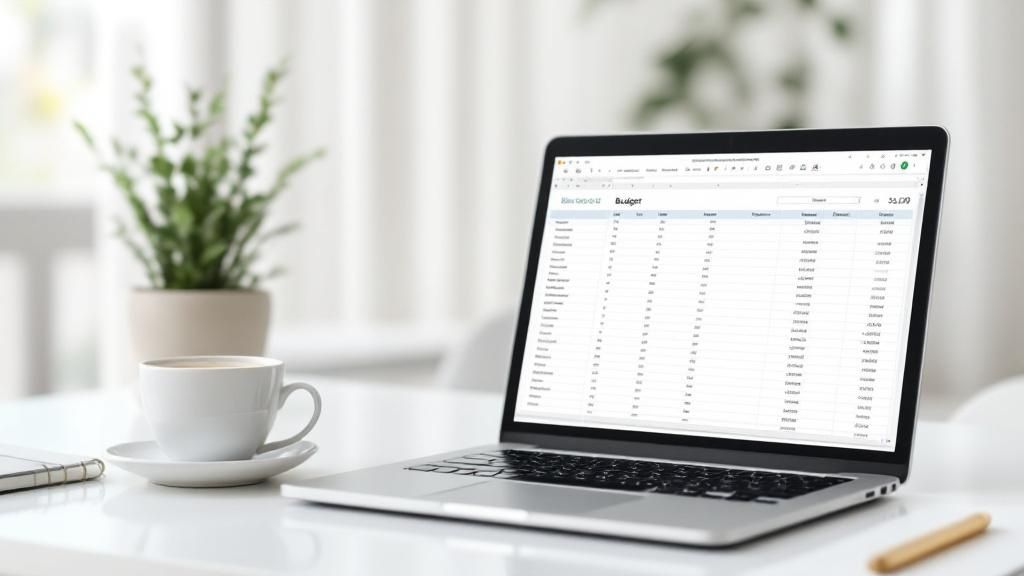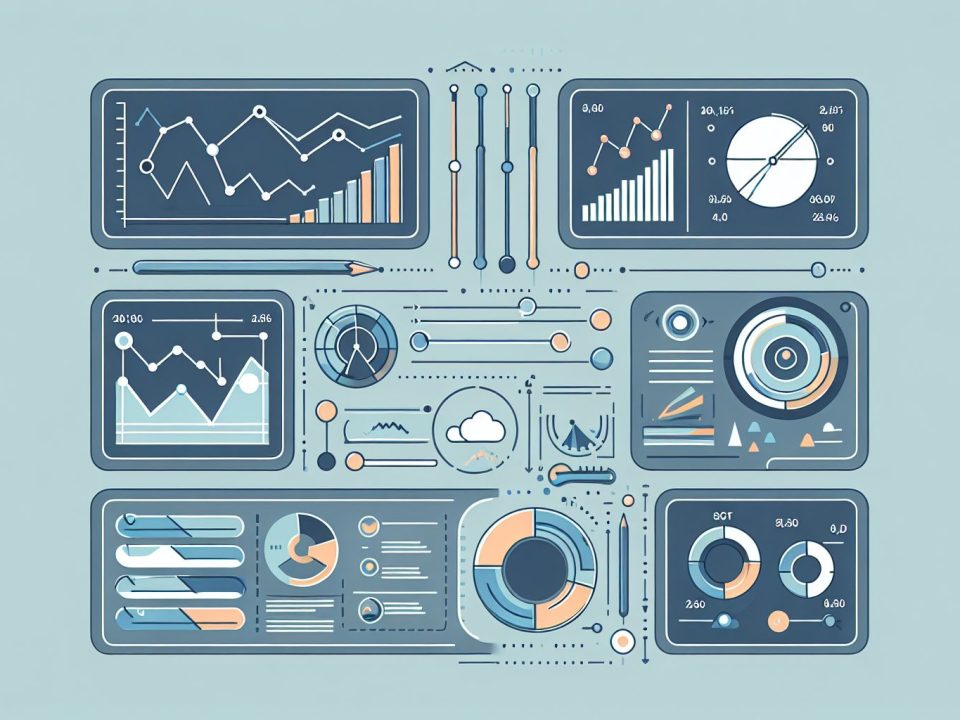
Property Investment in NZ: Essential Ownership Structures and Tax Considerations
October 3, 2025
South Auckland Accountants: Your Manukau-Based Partners for Business Growth and Compliance
October 7, 2025Creating a Business Budget That Truly Works
Let’s get real for a minute. The word “budget” can make even the most seasoned entrepreneur’s eyes glaze over. It sounds restrictive, tedious, and like a whole lot of spreadsheet headaches you just don’t have time for.
But creating a business budget isn’t about building a financial cage for your company. It’s about drawing a map. It’s the process of getting honest about what’s coming in and what’s going out, so you can stop guessing and start making smart, intentional decisions. This is your roadmap from just surviving to truly thriving.
Why Your Business Needs a Real Financial Roadmap

So many small business owners I’ve worked with fall into the same trap: they run their business by checking their bank account balance. If there’s money in the account, things are good. If it’s low, it’s time to panic. Sound familiar?
That approach is like trying to drive a car by only looking in the rearview mirror. You get a great view of where you’ve just been, but you have absolutely no idea what’s coming up ahead—be it a sharp turn, a dead end, or a wide-open highway.
This reactive, “look-in-the-bank-account” method keeps you stuck. You’re constantly putting out fires and reacting to financial surprises instead of getting ahead of them. A budget completely flips that script. It’s not about restriction; it’s about freedom. The freedom that comes from clarity and confidence.
From Guesswork to Growth
Think of a solid budget as the foundation for deliberate, strategic growth. It gives you a clear “why” behind every dollar you spend, making sure your money is working for your biggest goals, not against them.
Here’s what that looks like in the real world:
- Smarter Decisions: Wondering if you can afford that new hire or a bigger marketing push? Your budget has the answer. No more gut feelings, just data-backed choices.
- Grabbing Opportunities: When a golden opportunity comes knocking—like a bulk discount on inventory or a last-minute trade show spot—you’ll know instantly if you can jump on it.
- Dodging Problems: A good budget is like a crystal ball. It can show you potential cash flow shortages months down the road, giving you plenty of time to pivot before it becomes a crisis.
“A budget isn’t a financial straitjacket; it’s your business’s GPS. It shows you exactly where you are, where you want to go, and the best route to get there, helping you navigate detours and roadblocks along the way.”
Quick Budgeting Health Check
This table is a simple way to spot common financial pain points and understand how a budget directly addresses them.
| Symptom | What It Means | Why Budgeting Helps |
|---|---|---|
| “I’m profitable, but always broke.” | You likely have a cash flow problem. Money is tied up in accounts receivable or inventory. | A budget helps you forecast cash highs and lows so you can manage them proactively. |
| “I have no idea if I can afford this.” | Your spending isn’t tied to a plan. Decisions are made on impulse, not data. | Budgeting allocates funds to specific goals, giving you a clear “yes” or “no” on new expenses. |
| “Surprise bills always derail me.” | You’re operating without a safety net and underestimating your true costs. | A good budget includes a contingency fund and accounts for all expenses, even irregular ones. |
| “I feel stuck and can’t plan for growth.” | You’re so focused on daily survival that you can’t see the big picture. | Your budget creates the roadmap for growth, showing you exactly how to fund your ambitions. |
Seeing any of your own struggles in that table? You’re not alone. But the good news is, taking control starts now.
Ultimately, building a budget is the single most powerful step you can take to move from just keeping the lights on to building a genuinely profitable, sustainable business. It’s the tool that lets you finally take the wheel and steer your own financial destiny.
Gathering Your Financial Puzzle Pieces
Alright, before you can map out where you’re going, you need to know exactly where you stand. This first step is all about getting an honest, clear-eyed look at your business’s financial health.
Think of it like gathering all the pieces of a puzzle before you start putting it together. It can feel a bit like a treasure hunt, but trust me, getting this part right makes everything that follows so much smoother.
The goal here is simple: pull together all the data that tells your business’s financial story over the last six to twelve months. This look-back period is crucial. It helps you see the natural ebbs and flows of your business, spot spending habits (the good and the bad), and build a plan based on reality, not just wishful thinking.
Where to Dig for Your Numbers
Your financial info is probably scattered across a few different places, and that’s completely normal. Don’t stress about organizing everything perfectly just yet. For now, just focus on collecting. We need a comprehensive look at every dollar that came in and every dollar that went out.
Start by pulling these key documents:
- Bank Statements: Grab statements for all your business checking and savings accounts. This gives you the big-picture view of your cash flow.
- Credit Card Statements: Don’t skip these! This is often where the sneaky, small expenses hide—like those software subscriptions you forgot about or quick trips for office supplies.
- Sales Reports: Whether it’s from your point-of-sale system, Shopify dashboard, or invoicing software like QuickBooks, you need to know precisely where your money is coming from.
- Payroll Records: This isn’t just salaries. Make sure you include payments to contractors, payroll taxes, and any benefits you offer.
As you start pulling these puzzle pieces together, it’s a great time to learn how to create an effective budget template. Having a solid template ready will give you a place to plug in all this data and start making sense of it.
A budget is more than just numbers on a spreadsheet; it’s a plan. And like any good plan, it forces you to be intentional. Without gathering the real data first, you’re just building a plan on guesswork.
A Quick Data Collection Checklist
To make sure you don’t miss anything important, use this checklist as a guide. Comb through your records and find a figure for each of these categories from the past year.
Your Income Sources
- Direct Sales (from products or services)
- Recurring Revenue (like subscriptions or client retainers)
- Other Income (think affiliate commissions, ad revenue, or interest)
Your Business Expenses
- Office & Utilities: Rent, electricity, internet, phone bills.
- Software & Subscriptions: All those SaaS tools you pay for monthly or annually.
- Marketing & Advertising: Your ad spend, any content creation costs, or event sponsorships.
- Professional Services: Fees for your accountant, lawyer, or any consultants.
- Supplies & Inventory: The cost of raw materials or the products you sell.
- Salaries & Wages: Pay for both your employees and any freelancers or contractors.
Once you have all these documents and figures in hand, you’ve honestly done the hardest part. You’ve replaced vague feelings with cold, hard facts. Now you have everything you need to build a financial roadmap that will actually guide your business forward.
How to Make Sense of Your Income and Expenses

Alright, you’ve gathered all your financial data. Right now, it probably looks like a giant, messy pile of puzzle pieces. The next step is to start sorting them out so you can see the bigger picture. This is where the magic happens—categorizing turns that raw data from your bank statements into a story about where your money is really coming from and where it’s going.
The best place to start is by splitting your expenses into two main buckets: fixed costs and variable costs. Getting a handle on this distinction is absolutely fundamental to understanding your financial health and making smarter decisions down the road.
Getting a Grip on Your Fixed Costs
Fixed costs are your predictable, non-negotiable expenses. They show up every month like clockwork, regardless of how much you sell. Whether you have a blowout sales month or a painfully slow one, these bills are coming due.
Let’s say you run a small coffee shop. Your fixed costs are the essentials you have to cover just to keep the lights on:
- The rent for your storefront.
- Salaries for your full-time staff.
- Your monthly insurance premiums.
- Software subscriptions, like your point-of-sale (POS) system.
Because these costs are so stable, they’re the easiest part of your budget to plan for. Adding them all up gives you a crucial number: the absolute bare minimum you need to earn each month just to open your doors.
See our article: How to Calculate Break Even: Easy Step-by-Step Guide
Breaking Down Your Variable Costs
Now for the other side of the coin: variable costs. These are the expenses that go up and down right along with your business activity. When you’re slammed with customers, these costs rise. When things are quiet, they fall. They are directly tied to what you’re selling.
Back to our coffee shop example, the variable costs would be things like:
- Coffee beans and milk.
- Paper cups, sleeves, and lids.
Tracking these costs is how you figure out how profitable you are on every single item you sell. If the price of your coffee beans suddenly jumps by 15%, this is where you’ll spot it. That gives you the power to decide if you can absorb that hit or if you need to tweak your latte prices.
More here: Fixed vs. Variable Costs: Key Difference Explained
Don’t Forget to Categorize Your Income
Just like you sort your expenses, you need to do the same for your income. Most small businesses have a few different ways they make money, and it’s vital to know how much each one is contributing to the bottom line.
A freelance graphic designer, for instance, might have several income streams to track:
- Project-Based Work: One-off logo designs or website builds.
- Retainer Clients: Steady, recurring monthly income for ongoing design support.
- Digital Products: Passive income from an ebook or template pack sold on their website.
By separating income this way, you might discover that while you have fewer retainer clients, they actually account for 60% of your total revenue. That’s a huge insight! It signals a massive opportunity to focus your energy on landing more of that kind of work.
Using Your Budget to Forecast Future Growth
A business budget isn’t just a stuffy old spreadsheet for tracking what you’ve already spent. Think of it as your financial roadmap—a powerful tool for figuring out where you’re headed next. When you stop looking at it as a historical document and start seeing it as a playbook for the future, you can make some seriously smart moves.
By digging into your past financial data, you can begin to make some solid, educated guesses about what’s coming. You’re not trying to be a fortune-teller; you’re just using what you know to predict what you don’t. Looking at past sales cycles helps you anticipate future revenue, and you can predict your expenses with surprising accuracy. It’s all about making data-driven assumptions instead of just hoping for the best.
Weaving Growth into Your Financial Plan
This is where your budget really starts to shine—when you use it to actively chase down your business goals. You’re no longer just passively recording what happened; you’re proactively making things happen.
Got a big marketing push planned for next quarter? Or maybe you’re finally ready to hire your first full-time employee. These aren’t just ideas; they’re financial decisions that need to be baked right into your forecast.
Here’s a practical way to think about it:
- Marketing Campaigns: Instead of crossing your fingers and hoping you have enough cash, your budget tells you exactly what you can afford. You can model a 10% bump in your marketing spend and project the revenue you’d need to hit to make it worthwhile.
- New Hires: It’s not just about the salary. You have to factor in taxes, benefits, a new laptop, and software licenses. A good forecast helps you pinpoint the perfect time to bring someone on board without putting a squeeze on your cash flow.
- Equipment Purchases: Eyeing a new piece of tech that could make your team more efficient? Model the upfront cost and any monthly payments to see how it really impacts your bottom line.
Forecasting in a Changing World
Of course, your business doesn’t operate in a bubble. It’s crucial to look at how broader economic and tech trends might affect your spending. These outside forces can throw you a curveball or open up a huge opportunity, and a solid forecast helps you stay ready for either.
For instance, global IT spending is projected to hit an incredible $5.61 trillion in 2025—that’s a 9.8% jump from 2024. What does that mean for you? It means your own budget might need to make room for new software, digital tools, or tech upgrades just to keep up. By building these kinds of considerations into your forecast, you keep your business agile and ready to invest where it’ll matter most.
Making Your Budget a Living Document

I’ve seen it a hundred times. A business owner puts in the hard work to create a detailed budget, feels great about it, and then… it gets filed away, never to be seen again. This is probably the single biggest mistake you can make.
Think of your budget less like a static report and more like a GPS for your business. It’s a living, breathing guide that needs your attention to keep you on the right path. To get real value from it, you have to use it.
Checking In and Understanding What Changed
The real magic happens when you sit down—at least once a month—and compare your plan to reality. You’re looking for variances, which is just a fancy word for the differences between what you thought would happen and what actually happened.
But don’t stop there. The crucial part is digging into the why.
Did you blow your marketing budget? Okay, but why? Maybe an incredible, can’t-miss PR opportunity came up. That’s a strategic choice. Or maybe your main supplier jacked up their prices without warning. That’s a problem to solve. Each story is different and needs a different reaction.
The same goes for the good stuff. If you brought in way more revenue than you projected, pop the champagne… and then investigate! Did a new service catch fire? Did one of your clients suddenly bring you a massive project? When you know what’s working, you can do more of it.
Making Smart Adjustments on the Fly
Once you get why things are different from your plan, you can make intelligent adjustments. This is what keeps your business nimble and ready for anything.
Here are a few real-world examples I see all the time:
- You’re always overspending somewhere: If your marketing costs are consistently higher than you budgeted, maybe your initial number was just wishful thinking. It might be time to permanently shift some funds from a less critical area to give marketing the resources it actually needs.
- You get an unexpected cash windfall: That surprise project that just paid out? Awesome! Your budget helps you decide what to do next. Should you invest it in a new piece of equipment, pay down some high-interest debt, or beef up your cash reserves? Most of the time it isn’t draw the money out for yourself!
- A sales month goes south: When revenue dips, your budget is your roadmap for what to do. You can immediately see which variable costs—like ad spend, contract labor, or non-essential supplies—you can trim to protect your cash flow.
Got Budgeting Questions? We’ve Got Answers
Even with the best template in hand, you’re bound to run into a few head-scratchers when you first start budgeting. That’s completely normal. Let’s walk through some of the most common questions I hear from business owners so you can keep moving forward.
What’s the Best Tool for the Job?
Honestly, the “best” tool is the one you’ll actually use. It really comes down to your business’s size and what you’re comfortable with. There’s no magic bullet, but your options usually fall into a few buckets.
- Good Ol’ Spreadsheets: Think Google Sheets or Microsoft Excel. This is the classic starting point for a reason—it’s free and endlessly customizable. You can build a budget that’s a perfect fit for your business. The trade-off? It’s all manual, which means it can eat up your time and is ripe for human error. This is a great fit for freelancers or brand-new businesses with simple finances.
- Dedicated Accounting Software: This is where tools like Xero come in. They’re the industry standard for most small businesses. They sync with your bank accounts, pulling in transactions automatically and helping you categorize everything. This saves a huge amount of time and gives you a much clearer, real-time view of your financial health. If you’re growing, this is the way to go.
- All-in-One Platforms: Some tools bundle budgeting with other features like project management or a CRM. These can be fantastic for service businesses that need to track how profitable each project is, not just the company’s overall bottom line.
How Often Should I Check In on My Budget?
A budget isn’t something you create in April and forget about until March. It’s a living document that needs regular attention to be worth anything.
For most small businesses, a monthly review hits the sweet spot. It’s frequent enough to spot issues before they become major disasters but not so often that it feels like a chore.
When you do your monthly check-in, you’re looking at your budget vs. actuals. This is a simple comparison of what you thought you’d earn and spend versus what actually happened. The key is to ask “why.” Why was revenue up? Why did we blow the budget on supplies? The answers to those questions are pure gold—they’re what help you make smarter moves next month.
Help! I Keep Going Over Budget. What Now?
First off, take a breath. This is probably the most common budgeting problem out there. If you’re consistently in the red, it just means your plan and your reality aren’t quite on the same page yet. Don’t get discouraged; get curious.
The first step is to find the leaks. Dig into your spending reports and pinpoint exactly where the overages are happening. Is it one particular variable cost, like marketing ads, that keeps getting away from you? Or are your fixed costs, like rent or software subscriptions, actually higher than you estimated? You can’t plug a hole until you find it.
Once you know where the problem is, it might be time to re-forecast. Maybe your original budget was a little too optimistic. That’s okay! It’s far better to adjust your plan based on what you know now than to stick to an unrealistic budget. An accurate budget is always more valuable than a “perfect” one that doesn’t reflect the real world.
Finally, give yourself some breathing room and build in a contingency fund. Seriously, life happens. Having a small buffer—even just 5% of your total expenses—can be a lifesaver. It turns an unexpected bill from a full-blown crisis into a manageable bump in the road.
See our article: How to Create a Realistic Business Budget
Navigating your business finances can be tricky, but you don’t have to do it alone. The team at Business Like NZ Ltd specializes in helping small businesses in Auckland gain financial clarity and build a roadmap for growth. Let’s create your financial freedom together.




